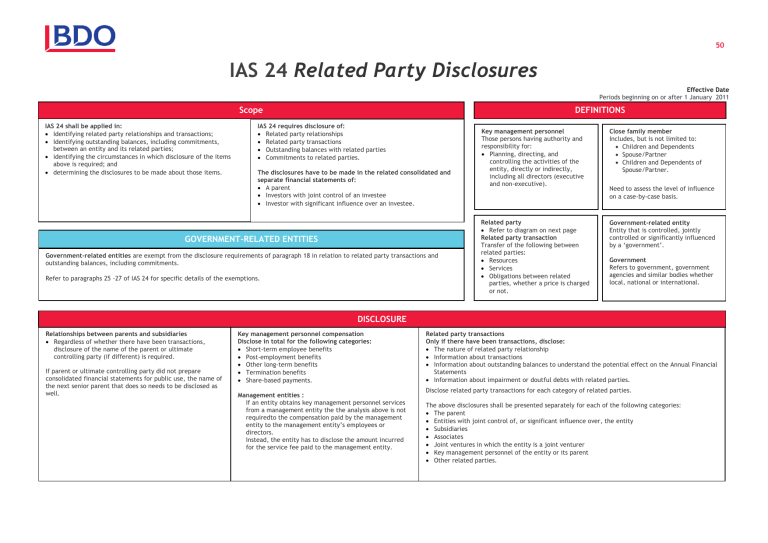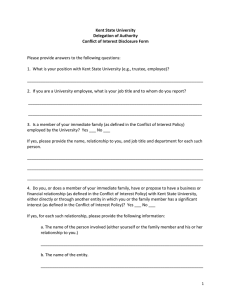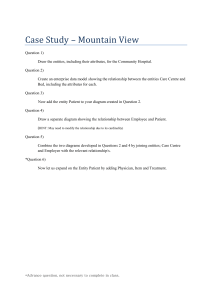
50 IAS 24 Related Party Disclosures Effective Date Periods beginning on or after 1 January 2011 Scope IAS 24 shall be applied in: Identifying related party relationships and transactions; Identifying outstanding balances, including commitments, between an entity and its related parties; identifying the circumstances in which disclosure of the items above is required; and determining the disclosures to be made about those items. DEFINITIONS IAS 24 requires disclosure of: Related party relationships Related party transactions Outstanding balances with related parties Commitments to related parties. The disclosures have to be made in the related consolidated and separate financial statements of: A parent Investors with joint control of an investee Investor with significant influence over an investee. GOVERNMENT-RELATED ENTITIES Government-related entities are exempt from the disclosure requirements of paragraph 18 in relation to related party transactions and outstanding balances, including commitments. pecific quantitative disclosure requirements: Refer to paragraphs 25 -27 of IAS 24 for specific details of the exemptions. Key management personnel Those persons having authority and responsibility for: Planning, directing, and controlling the activities of the entity, directly or indirectly, including all directors (executive and non-executive). Close family member Includes, but is not limited to: Children and Dependents Spouse/Partner Children and Dependents of Spouse/Partner. Related party Refer to diagram on next page Related party transaction Transfer of the following between related parties: Resources Services Obligations between related parties, whether a price is charged or not. Government-related entity Entity that is controlled, jointly controlled or significantly influenced by a ‘government’. Need to assess the level of influence on a case-by-case basis. Government Refers to government, government agencies and similar bodies whether local, national or international. DISCLOSURE Relationships between parents and subsidiaries Regardless of whether there have been transactions, disclosure of the name of the parent or ultimate controlling party (if different) is required. If parent or ultimate controlling party did not prepare consolidated financial statements for public use, the name of the next senior parent that does so needs to be disclosed as well. Key management personnel compensation Disclose in total for the following categories: Short-term employee benefits Post-employment benefits Other long-term benefits Termination benefits Share-based payments. Management entities : If an entity obtains key management personnel services from a management entity the the analysis above is not requiredto the compensation paid by the management entity to the management entity’s employees or directors. Instead, the entity has to disclose the amount incurred for the service fee paid to the management entity. Related party transactions Only if there have been transactions, disclose: The nature of related party relationship Information about transactions Information about outstanding balances to understand the potential effect on the Annual Financial Statements Information about impairment or doutful debts with related parties. Disclose related party transactions for each category of related parties. The above disclosures shall be presented separately for each of the following categories: The parent Entities with joint control of, or significant influence over, the entity Subsidiaries Associates Joint ventures in which the entity is a joint venturer Key management personnel of the entity or its parent Other related parties.




